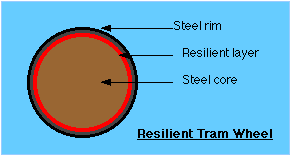Return to Homepage
Tram Wheels
Tram wheels used to be renowned for the rumbling
noise they produced. This was felt through the ground and heard
inside buildings near a tramway.
Nowadays, trams are so quiet, they cannot be heard at all in normal
traffic. This is because the wheels and track
are now made resilient.
 The metal tyre
of the wheel is only a small part of its total mass, and by having
a layer of rubbery material between this and the rest of the wheel,
the pounding effects of a solid mass of metal on the minute irregularities
of the track are reduced. There is enough elasticity to allow
the tyre to take-up the movement without moving the whole mass
of the wheel and axle.
The metal tyre
of the wheel is only a small part of its total mass, and by having
a layer of rubbery material between this and the rest of the wheel,
the pounding effects of a solid mass of metal on the minute irregularities
of the track are reduced. There is enough elasticity to allow
the tyre to take-up the movement without moving the whole mass
of the wheel and axle.
Careful design is necessary to ensure the tyre is captive and
cannot come off, even if the bonding material fails completely;
but the tyre can still be changed easily when required.
Further technical information
Under excessive braking conditions, the heat generated at the
contact point of a wheel tread, sliding along the rail, is so
sudden and intense that the metal fractures in a characteristic
way and shells-out [98kb]
, leaving a crater or flat spot.
Originally, tram wheels were made of cast iron, in moulds fitted
with a metal ring which chilled the molten metal as it set and
produced a very hard skin on the running surface.
These chilled iron wheels were
so hard on the surface that they could only be re-shaped, after
developing a flat, by grinding. An ordinary lathe tool would not
cut them. When the hard surface had been worn, or ground, away,
the softer iron underneath was useless and the whole wheel had
to be scrapped and re-cast. These types of tram wheels usually
had a running life of well over 100,000 miles
To reduce scrappage, wheels with a cast iron centre but a steel
tread were introduced. Not only could the tread be re-shaped in
a lathe, which was more straightforward than grinding; but, when
worn out, it could be cut off the wheel and a new one fitted.
The coefficient of friction of a steel tyre on a steel rail is
greater than that of a chilled cast iron wheel, reducing the chance
of skidding on hills or during braking.
Steel tyres are still used and their life is now extended to
many hundreds of thousands of miles by the resilient inserts and
by the use of differential gears in the
vehicles.
Use "Back"in browser menu to return
 The metal tyre
of the wheel is only a small part of its total mass, and by having
a layer of rubbery material between this and the rest of the wheel,
the pounding effects of a solid mass of metal on the minute irregularities
of the track are reduced. There is enough elasticity to allow
the tyre to take-up the movement without moving the whole mass
of the wheel and axle.
The metal tyre
of the wheel is only a small part of its total mass, and by having
a layer of rubbery material between this and the rest of the wheel,
the pounding effects of a solid mass of metal on the minute irregularities
of the track are reduced. There is enough elasticity to allow
the tyre to take-up the movement without moving the whole mass
of the wheel and axle.